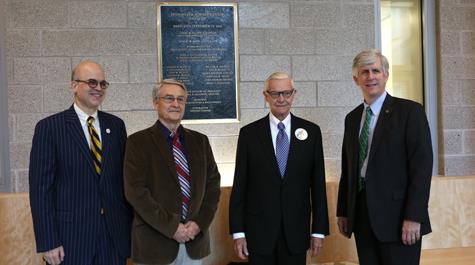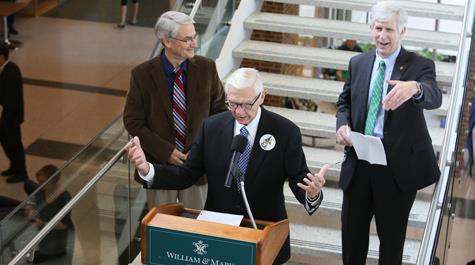Integrated Science Center: Phase 3 set to stun
Hannes Schniepp uses atomic force microscopy to examine the molecular structure of complex materials such as silk and spider webs. It’s a sensitive technique, and one that just doesn’t do well with vibration.
So, Schniepp installed his AFM lab on the ground floor of McGlothlin-Street Hall, the most vibration-free place available. Even working this low in the building, the lab staff is so vibration-averse that no one talks while an atomic force microscope is being used. Breathing is permissible, as long as it is kept low and regular.
And it worked — until the geologists next door fire up their rock saw.
Those were the old days. (And courteous collegial coordination with the Department of Geology forged a schedule that allowed the use of both instruments.) Since August, Schniepp, an associate professor in William & Mary’s Department of Applied Science, has been using his atomic force microscopes in his solid, new lab in the university’s brand-new science building, known as the Integrated Science Center, phase 3.
‘113,000 square feet of badly needed, really attractive, new space’
ISC 3 came on line for the beginning of the semester and was dedicated at a Sept. 22 ceremony held in conjunction with the fall meeting of the university’s Board of Visitors. University President Taylor Reveley, welcomed the audience, which included Virginia’s Attorney General Mark R. Herring, to “latest, glorious manifestation” of the physical transformation of William & Mary’s science facilities.
“We’re now here to dedicate its 113,000 square feet of badly needed, really attractive, new space,” Reveley said. “ISC phases 1, 2 and 3 now total more than 230,000 square feet added to our science facilities in the last decade, creating a really state-of-the-art integrated, interdisciplinary science center.”
Reveley introduced Rector Todd A. Stottlemyer ’85, who praised the architecture of the ISC 3 as well as the integrated-science concept. Stottlemyer also expressed the university’s gratitude for the state’s fiscal support of William & Mary scientists.
“ISC represents a sustained, decade-long investment in the sciences at William & Mary. $77.9 million for Phase 3 and a total of $142.8 million across all three phases,” Stottlemyer said. “And we are very, very grateful to the Commonwealth of Virginia for the support and investment that the Commonwealth has made in William & Mary.
“William & Mary is a great STEM university,” he continued. “And this is evidence of our commitment to science and technology — and engineering at some point, as well.”
The new construction collects the departments of applied science, biology, chemistry, high performance computing and psychology — as well as major elements of the university’s programs in environmental science and neuroscience — in a set of interconnected buildings. ISC 3 also includes William & Mary’s High Performance Computing team, attesting to the importance of computational power to science in the 21st century.
The key to the building is the “integration” concept, Eric Bradley said in his remarks at the ISC 3 dedication.
“This is truly a beautiful building, but it’s more than that. It’s very specifically designed for interdisciplinary research, as well as the traditional programmed research. We deliberately designed and built in places to meet, to interact — some in a semi-private way with rooms and a door, but also in these wide-open spaces,” he said.
“This allows people from different disciplines to get together to share their expertise on a common question or a common problem,” Bradley added. “The building is built clearly in support of interdisciplinary science, teaching —and research.”
Better facilities = more science, better science
Bradley has a dual role in the ISC. He is chair of the Department of Biology and also is emergency and planning coordinator for Arts & Sciences. He and the William & Mary scientists working in their new ISC 3 labs believe the new facilities will advance the research footprint of the university in a number of ways.
“My speculation is that it’s going to be twice as productive,” said Christopher Del Negro shortly before moving his lab into the ISC 3 in August. An associate professor and chair of the applied science department, Del Negro is a member of William & Mary’s neuroscience program. His lab explores the neural control of respiration and he says that doubling in productivity could come in output and/or in quality of research.
“Once we’re under the same roof as biology and chemistry — and with many of my neuroscience colleagues — I think we’re going to have twice as many opportunities for collaboration,” Del Negro added.
The neuroscience program involves faculty from five departments: applied science, biology, chemistry, kinesiology & health sciences and psychology. Until ISC 3 opened, William & Mary’s neuroscientists were located in four different buildings. Now, the neuroscience faculty are housed in the Integrated Science Center complex — all of them but two, one of whom happens to be Robin Looft-Wilson, the neuroscience program director.
Looft-Wilson, who is an associate professor in the Department of Kinesiology & Health Sciences, will remain in Adair Hall, as will Michael Deschenes, a professor and chair of the same department. Looft-Wilson points out that the neuroscience program, which now involves 167 undergraduate majors and 20 participating faculty, finally has its own central base.
“We have three rooms in ISC 3,” Looft-Wilson explained. “Our coordinator, Christy Porter, will have her office there. She is often the first contact for students. We have a meeting room and we have a shared lab space for microscopy and behavioral neuroscience.”
Cabell Challenge helps with new lab instruments
Not only is the building purpose-built for research and designed for collaboration among researchers, but the ISC 3 also is being equipped with a wide range of new lab instruments, much of it through a matching initiative known as the Cabell Challenge.
In his remarks, Stottlemyer recognized the Cabell Foundation, which put up $500,000 for new instrumentation, that sum to be matched by $1 million raised by William & Mary.
“It’s not just the physical structure that makes a great science building,” he said. “You have to have state-of-the-art equipment, so we’re very thankful to the Cabell Foundation.”
Another William & Mary neuroscientist, Joshua Burk, is chair of the psychology department. He believes the new facilities and influx of up-to-date instrumentation will enhance researchers’ efforts to secure grants in an era of tight budgets.
“It has become increasingly competitive to receive extramural funding,” Burk said. “I believe that some of the equipment that we’ve gotten as part of the ISC project is going to make our department more competitive for grants.”
For example, Burk said the department is replacing its shared electroencephalogram (EEG) system, an instrument nearing the end of its life expectancy, with a new, better EEG system.
“It will allow us to measure EEG activity in two individuals at the same time,” he said. “That opens up a whole new set of questions about social interactions and synchrony between individuals’ neural activity while they’re engaged in a conversation or a cognitive task that they’re engaged in.
“That’s the kind of cutting-edge technology that you need in order to become more competitive in grants,” Burk said.
Windows on the scientific process
The dedication was held in the ISC’s atrium, an airy common space that holds a coffee shop and seating. The atrium is fronted by four “display labs,” each of which features large glass windows, inviting people to look in and see science being done.
At present, the display labs include a team of chemists who are working on ways to make radiation-shielding bricks out of the regolith of Mars, a non-destructive evaluation laboratory, a spectroscopy lab and the Biological Sciences Makerspace — the new home of William & Mary’s defending world champion undergraduate iGEM synthetic biology team.
Visitors looking into the lab windows are almost certain to see students at work, as it’s quite common for William & Mary undergraduates to join graduate students and faculty in research. But the new facilities of the ISC 3 are not just for research. The 294-seat lecture hall, ISC 1221, replaces the venerable, dingy Millington 150 as the largest auditorium on campus and will be the venue for many of the university’s large-enrollment classes.
The facilities in the new building include a number of teaching labs as well. Laurie Sanderson says the new ISC 3 teaching labs enhance the concept of collaboration.
“The students love the teaching labs. They’re much more open in their organization, so the students can sit around the tables as they need to work on various experiments or projects,” she said. “Collaboration is encouraged by the arrangement of the tables and the stools.”
Sanderson, a professor of biology, moved her labs and offices from Millington, as did other members of her department. She noted that the teaching labs feature the large windows that grace the research labs.
“It’s bright and airy. And it’s incredibly open,” she said. “Students working inside can look outside; students walking by outside can see all the activity and the intellectual conversation going on inside the lab. It’s all very conducive to interaction and conversation. The AV is beautiful: the audio-visual facilities, screens, lights, boards, everywhere!”
Atrium and study spaces make an instant student magnet
The ISC 3 atrium began attracting William & Mary students immediately. Mark Hinders is a professor of applied science and the proprietor of one of the display labs looking out on the atrium. He said he was pleased at the popularity of the atrium among students.
“Eight o’clock, Saturday morning. The place is full of students!” he said. “They’re studying. Even on Labor Day weekend, they were out there.”
Reveley complimented the ISC 3 architectural firm of Einhorn Yaffee and Prescott as well as the construction team of Whiting-Turner Contractor. “They deserve our praise for their excellent work,” he said.
The Integrated Science Center concept will continue with the development of ISC 4, another phase that will bring in faculty from William & Mary’s Department of Computer Science and Department of Mathematics. ISC 4 is planned for construction on the site now occupied by Millington Hall, which opened in 1968.
“With the advent of ISC 3, Millington can now rest from its labors,” Reveley said. “It can go to its reward. It can die an unmourned death. And I sense the Grim Reaper is approaching.”
Dennis Manos, William & Mary’s vice provost for research, did not speak at the dedication, but pronounced himself delighted at the opening of ISC 3.
“I couldn’t be happier,” he said. “Oh, yeah I could. ISC 4, attached later, will make me even happier. 125 percent, 133 percent happier. Depending.”















